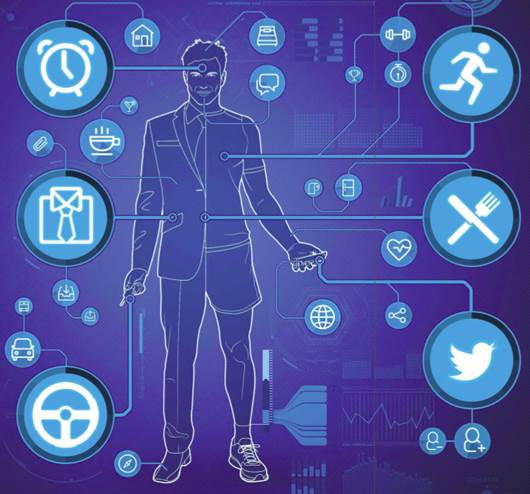Barry Collins spends a month logging
everything about his life using a variety of apps and gadgets. Did he learn
anything worthwhile?

Lifelogging
research of Barry Collins
My name is Barry Collins. I’m 6ft 3in and
weigh 14st Sib, although if I continue to lose weight at my current trajectory,
by the time you read this I’ll be 13st 131b. Yesterday, I consumed 2,547
calories and 30g of saturated fat: my fourth-highest daily fat intake in the
past month.
Thankfully, the damaging effects of that
lunchtime “gourmet” hot dog in Wetherspoons (976 calories) and four pints of
Guinness at the football (796) were more than offset by walking 11,679 steps,
or 5.66 miles, over the course of the day, burning off 709 calories.
Last night I slept 6hrs 48mins, although I
showed signs of restlessness on no fewer than 18 occasions, totaling 36
minutes. I was particularly fidgety just after midnight and at 4.54am, although
I have no recollection of either period of twilight activity. Whatever kept me
tossing and turning, it wasn’t as bad as 20 February, when I woke up no fewer
than 29 times in the night, a dubious personal record.
Last week, only 45% of my working time at
the computer was “productive” or “very productive”, a Ml of 22% from the week
before. My most-used application was Microsoft Word (4hrs 40mins over the
course of the week), although I “wasted” almost as much time (4hrs 28mins)
using the Twitter client TweetDeck.
I know all of this and more (much, much
more) because for the past month I’ve been using a barrage of apps and devices
to track almost every aspect of my life.
My existence has become one of The Police’s
greatest hits: every move I make, every step I take, I’ve been watching...
well, me.

“Every
move I make, every step I take, I’ve been watching”.
The point? To test which of these many
forms of personal surveillance are most effective, but more importantly, to
discover whether meticulously logging every aspect of our personal and
professional lives has any real benefit.
Are we really any better off for knowing
how many minutes we spent on Facebook during work time yesterday, or how many
times we woke in the night?
Or does it merely confirm what, deep down,
we already know? That we should eat more greens, take more exercise and stop
looking at Facebook every five minutes. Here are the conclusions of my
month-long experiment.
Diet
When it comes to tracking what you’re
shovelling down your throat on a daily basis, there are more services to choose
from than flavours of Pot Noodle, but MyFitnessPal is emerging as the Facebook
of the health scene, hungrily devouring rival apps to become an
all-encompassing portal for tracking diet and exercise.

My
Fitness Pal is a free online calorie counter to help you count
and calculate calories for everything that you eat
MyFitnessPal lets you log your diet through
its website or via its mobile apps for Android, iOS, Windows Phone or
BlackBerry. You’re encouraged to log in via Facebook, which left me fearful
that MyFitnessPal would start automatically posting vindictive updates to my
friends - “Barry just smashed through his daily calorie target with a bacon
double cheeseburger and fries, the fat idiot.” Mercifully, it has thus far
refrained from divulging my refuelling habits, and signing in through Facebook
makes it easier to connect MyFitnessPal to other exercise apps.
The scale of MyFitnessPal’s food database
is extraordinary. It claims to have nutritional details of more than three
million different items. You don’t just have “lasagne” for tea. Oh, no. You
have to pick from Marks & Spencer’s Beef Lasagne, Weight Watchers’ Chicken,
Tomato & Spinach Lasagne, Pizza Express’ Lasagna Classica or dozens of
other options. It sounds intimidating, but its search engine is super-efficient
- you can even scan food items’ barcodes using the mobile app, although that
didn’t work on my Android phone -and when the difference between one brand of
lasagne and another can be 1,000 calories per serving, the granularity of that database is what sets MyFitnessPal apart.